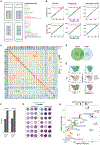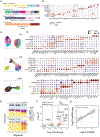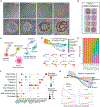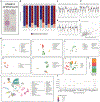STAMP: Single-cell transcriptomics analysis and multimodal profiling through imaging
- PMID: 40532697
- PMCID: PMC12551790
- DOI: 10.1016/j.cell.2025.05.027
STAMP: Single-cell transcriptomics analysis and multimodal profiling through imaging
Abstract
Single-cell RNA sequencing has revolutionized our understanding of cellular diversity but remains constrained by scalability, high costs, and the destruction of cells during analysis. To overcome these challenges, we developed STAMP (single-cell transcriptomics analysis and multimodal profiling), a highly scalable approach for the profiling of single cells. By leveraging transcriptomics and proteomics imaging platforms, STAMP eliminates sequencing costs, enabling cost-efficient single-cell genomics of millions of cells. Immobilizing (stamping) cells in suspension onto imaging slides, STAMP supports multimodal (RNA, protein, and H&E) profiling, while retaining cellular structure and morphology. We demonstrate STAMP's versatility by profiling peripheral blood mononuclear cells, cell lines, and stem cells. We highlight the capability of STAMP to identify ultra-rare cell populations, simulate clinical applications, and show its utility for large-scale perturbation studies. In total, we present data for 10,962,092 high-quality cells/nuclei and 6,030,429,954 transcripts. STAMP makes high-resolution cellular profiling more accessible, scalable, and affordable.
Keywords: cell atlas; circulating tumor cells; genomics; imaging; multimodal; phenotyping; proteomics; single cell; stem cells; transcriptomics.
Copyright © 2025 The Authors. Published by Elsevier Inc. All rights reserved.
Conflict of interest statement
Declaration of interests H.H. is co-founder and chief scientific officer of Omniscope, a scientific advisory board member at Nanostring/Bruker and Mirxes, a consultant for Moderna and Singularity, and has received honoraria from Genentech. L.G.M. is scientific advisor of ArgenTag. L.G.M. and J.T.P. have filed a patent application based on this work (US Provisional Patent Application no. 63/723,044;63/737,985).
Figures







References
MeSH terms
Grants and funding
LinkOut - more resources
Full Text Sources

